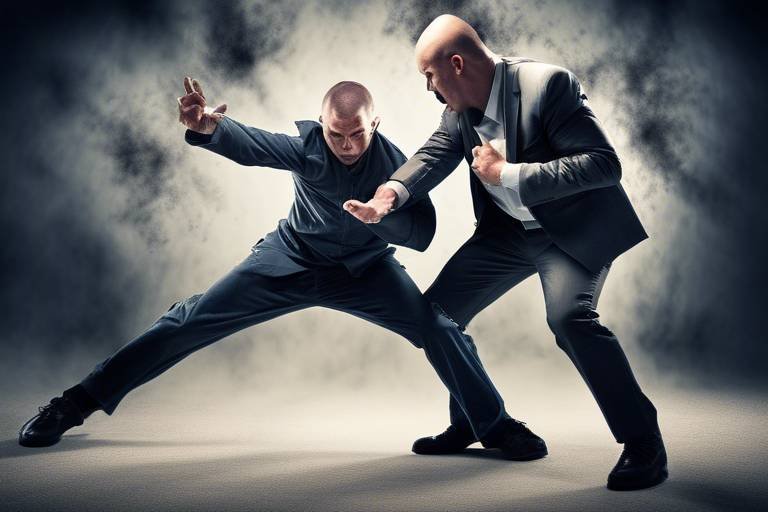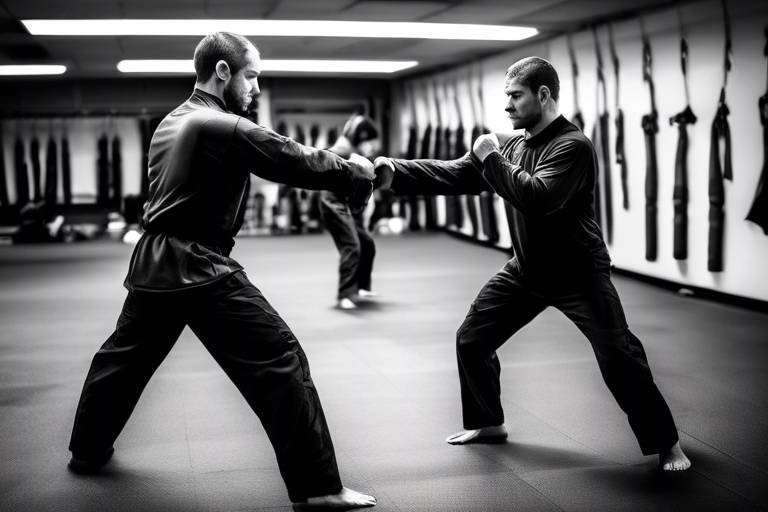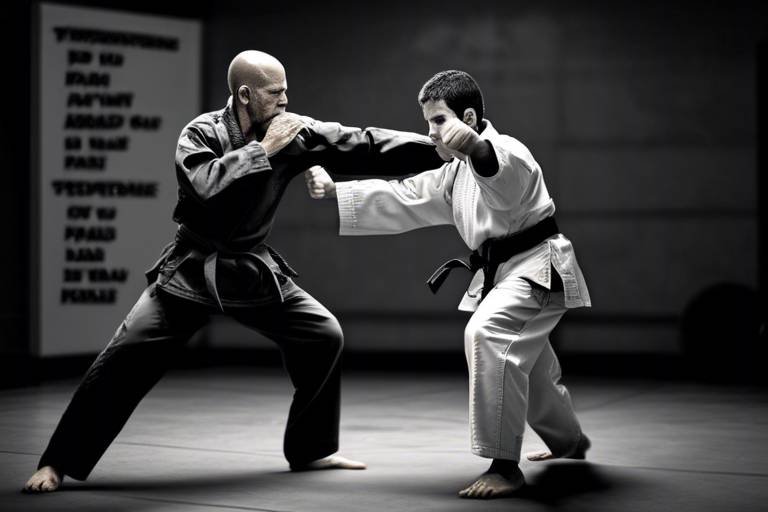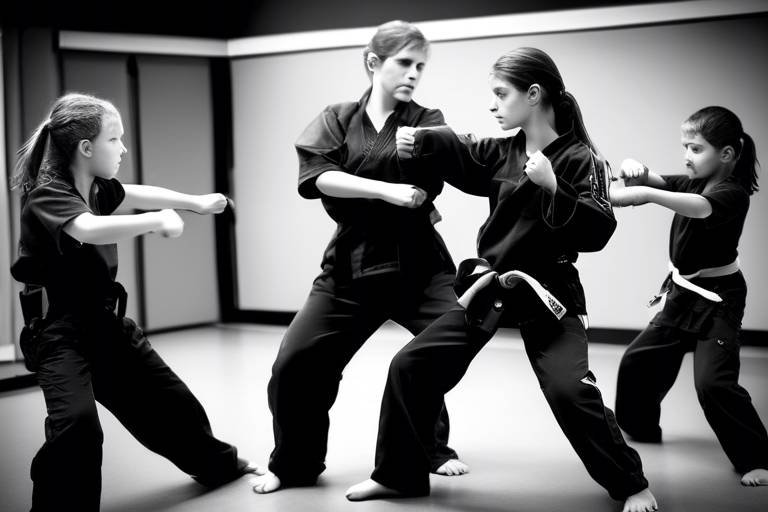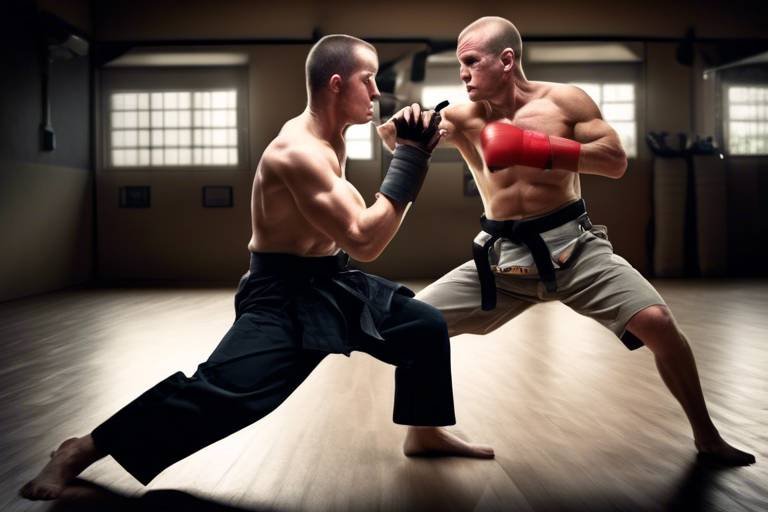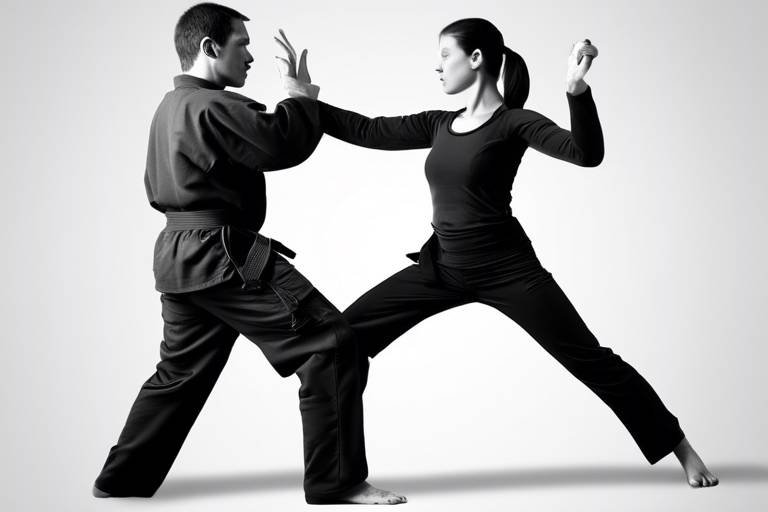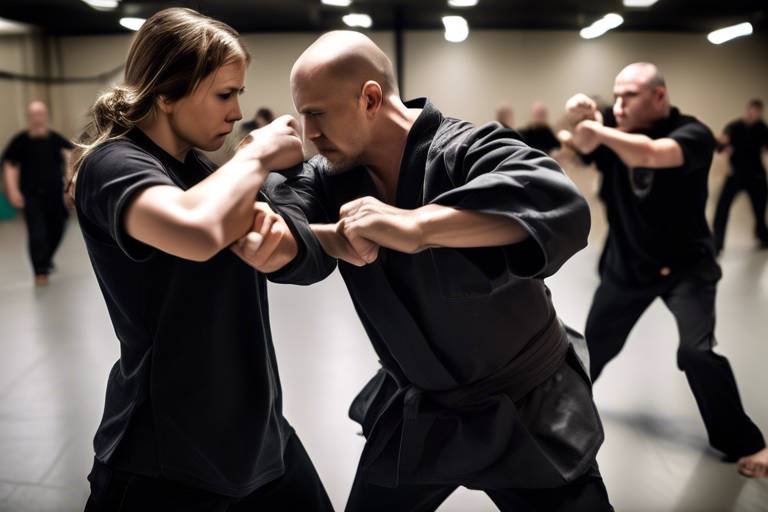Five Easy Self-Defense Techniques to Learn While You Social Distance
In today's world, personal safety is paramount. With the ongoing challenges we face, it's essential to equip ourselves with the knowledge and skills to protect ourselves. This article explores five simple self-defense techniques that can be practiced at home, helping you stay safe while maintaining social distance. Whether you're a beginner or just looking to brush up on your skills, these techniques are designed to be easy to learn and effective in real-life situations.
Self-defense is crucial for personal safety. Knowing self-defense techniques can be a game changer; it empowers individuals and enhances their confidence in various situations. Imagine walking down the street, feeling secure and self-assured, knowing you can handle unexpected encounters. This sense of empowerment is especially important during challenging times when the world can feel uncertain. By learning self-defense, you not only protect yourself but also cultivate a sense of control over your environment.
A solid foundation is essential for effective self-defense. The basic stance is your starting point, providing balance and preparing you for any defensive action. To adopt the proper stance, stand with your feet shoulder-width apart, knees slightly bent, and your dominant foot a step back. This position allows you to move quickly in any direction, giving you the agility needed to react to threats. Remember, a strong stance is like the roots of a tree; it keeps you grounded and ready to face any storm.
The palm strike is a simple yet effective technique. To execute this move properly, raise your hand and strike with the heel of your palm, targeting the attacker's nose or chin. This technique minimizes the risk of injury to yourself, as your palm is less likely to break compared to a fist. Think of it as a powerful push rather than a punch; it’s all about precision and intent. Practicing this strike can give you the confidence to defend yourself without overexerting yourself.
Knee strikes can be powerful in close encounters. When an assailant is within arm's reach, driving your knee into their groin or abdomen can be incredibly effective. Focus on your target areas, as these strikes can disable an attacker temporarily, giving you the chance to escape. The mechanics of the strike are simple: lift your knee sharply and aim for the vulnerable spots. It’s like striking a match; it ignites a quick reaction that can turn the tide in your favor.
Elbow strikes are versatile and effective at close range. When you find yourself in a tight situation, your elbows become powerful tools for defense. To execute an elbow strike, bring your elbow down or sideways into your attacker's face or body. The key is to maintain your balance and use your body weight to enhance the impact. Think of your elbow as a hammer; it can deliver a powerful blow without requiring much space. Practicing this technique can prepare you for close-quarters confrontations.
Knowing how to escape is vital in self-defense. If confronted by an attacker, your primary goal should be to get away safely. Various escape techniques can be employed, such as breaking free from holds or using your surroundings to your advantage. For instance, if an attacker grabs your wrist, twist your arm and step back to create distance. Remember, escaping is not a sign of weakness; it’s a smart strategy to ensure your safety above all. It’s like a chess game; sometimes, the best move is to retreat to a safer position.
Practicing self-defense techniques at home is essential for retention. Create a safe practice environment by clearing space and using a mirror to observe your form. Incorporate these techniques into your routine, perhaps setting aside a few minutes each day to practice. Consistency is key; just like learning to ride a bike, the more you practice, the more natural it becomes. You can even involve family members or friends for a fun and engaging practice session.
Awareness is a key component of self-defense. Being aware of your surroundings can prevent potential threats before they escalate. Practice situational awareness by observing people and situations around you. It’s like being a detective in your own life; notice the details that others might overlook. Keeping your head up, avoiding distractions like your phone, and being mindful of your environment can significantly enhance your safety.
- Q: Do I need prior experience to learn these techniques?
A: No prior experience is necessary! These techniques are designed for beginners and can be learned at your own pace. - Q: How often should I practice these techniques?
A: Regular practice is recommended. Aim for at least a few minutes each day to build muscle memory. - Q: Can these techniques be effective against larger attackers?
A: Yes! The techniques focus on targeting vulnerable areas, which can be effective regardless of the attacker's size.

Understanding the Importance of Self-Defense
In a world that can sometimes feel unpredictable, personal safety has never been more crucial. Understanding the importance of self-defense goes beyond just knowing how to throw a punch or execute a kick; it’s about empowering yourself to navigate your environment with confidence. Imagine walking down the street, feeling a sense of security because you know you have the skills to protect yourself if the need arises. This feeling of empowerment can dramatically change how you interact with the world around you.
Self-defense techniques can enhance your awareness and preparedness, especially during challenging times when anxiety levels may be heightened. When you equip yourself with these skills, you're not just learning to react to threats; you're also cultivating a mindset of vigilance and resilience. Think of self-defense as a toolkit that you can draw from when faced with potential danger. It’s not just about physical confrontation; it’s about understanding your surroundings and recognizing potential threats before they escalate.
Moreover, self-defense training can have profound psychological benefits. It can boost your self-esteem and instill a sense of control over your own safety. The knowledge that you can defend yourself if necessary can reduce feelings of vulnerability and anxiety. This is particularly important in today’s climate, where many people may feel uneasy about their safety. In essence, learning self-defense is an investment in your mental and emotional well-being as much as it is in your physical safety.
As you delve into self-defense, you’ll discover that it’s not just about the physical techniques; it’s also about developing a proactive mindset. Here are some key reasons why self-defense is essential:
- Empowerment: Knowing how to defend yourself can give you a significant boost in confidence.
- Prevention: Awareness and knowledge can help you avoid dangerous situations before they occur.
- Resilience: Learning self-defense can prepare you mentally to handle unexpected situations calmly.
Ultimately, understanding the importance of self-defense is about more than just personal safety; it's about transforming your mindset and preparing yourself to face whatever life throws your way. It’s about being proactive rather than reactive, ensuring that you can navigate the world with a sense of security and confidence. So, as you embark on your journey to learn self-defense techniques, remember that you are not just learning how to fight; you are learning how to empower yourself.

Technique 1: The Basic Stance
When it comes to self-defense, the basic stance is your foundation. Think of it like the bedrock of a house; without it, everything else could crumble. Adopting a proper stance not only provides you with balance but also prepares your body for any defensive actions that may follow. Imagine standing like a tree, rooted and unmovable, ready to respond to whatever comes your way. This stance is crucial because it allows you to maintain your center of gravity while keeping your limbs ready to react.
To achieve the basic stance, follow these simple steps:
- Feet shoulder-width apart: This gives you a stable base.
- One foot slightly back: Position one foot behind the other, creating a staggered stance that enhances your balance.
- Knees slightly bent: Keeping your knees relaxed helps absorb any impact and allows for quick movements.
- Hands up: Keep your hands at chin level, ready to defend or strike. This position protects your face while also allowing you to strike effectively.
Now, let’s talk about the mental aspect. When you’re in this stance, you should feel confident and ready. It’s like being a coiled spring, full of potential energy waiting to be released. Whether you’re facing a potential threat or just practicing at home, this stance keeps you grounded and aware of your surroundings. You’ll want to practice this stance regularly until it feels natural, as muscle memory will play a significant role in your ability to react quickly in a real situation.
In addition to practicing the physical aspects, consider your environment. Stand in front of a mirror to check your form. Are your feet aligned? Is your posture correct? This self-assessment will help you refine your stance. Remember, the basic stance is not just about standing still; it’s about being ready to move, defend, or escape at a moment’s notice.
Lastly, don’t underestimate the power of visualization. Picture yourself in various scenarios where you might need to use your stance. This mental rehearsal can be just as important as physical practice. By incorporating these elements into your routine, you’ll not only master the basic stance but also build a solid foundation for the self-defense techniques that follow.

Technique 2: The Palm Strike
The palm strike is one of the most effective and easiest self-defense techniques you can learn. Why? Because it utilizes the strength of your entire body rather than just your arms, making it a powerful tool in your self-defense arsenal. Imagine you're in a situation where you need to defend yourself; instead of relying on a fist, which can easily lead to injury, you can use your palm to deliver a strong, impactful blow. This technique is not only simple to execute but also minimizes the risk of hurting yourself.
To perform a palm strike effectively, follow these steps:
- Stand Firm: Start with your feet shoulder-width apart. This stance gives you stability and balance, which is crucial for generating power.
- Focus on Your Target: Identify the target area on your attacker. The nose, chin, or forehead are ideal spots. Striking these areas can cause disorientation and give you a chance to escape.
- Use Your Body Weight: As you prepare to strike, shift your weight from your back foot to your front foot. This motion will help you generate more force behind your palm strike.
- Strike with Your Palm: With your fingers curled slightly inward to protect them, extend your arm and strike using the base of your palm. Aim for the target area with a quick, snapping motion.
One of the best things about the palm strike is that it can be used in various scenarios. Whether you're standing face-to-face with an attacker or trying to defend yourself in a crowded space, this technique can be adapted to fit your needs. Moreover, it’s a great move to practice at home, allowing you to build muscle memory and confidence.
Moreover, the palm strike can be combined with other techniques for maximum effectiveness. For example, after delivering a palm strike, you could follow up with a knee strike or an escape maneuver, depending on the situation. Think of it as a chain reaction; one move leads to another, creating an opportunity for you to get away safely.
In summary, mastering the palm strike is a valuable addition to your self-defense skills. Not only does it empower you to defend yourself, but it also boosts your confidence. So, take a moment to practice this technique regularly. You never know when you might need it!

Technique 3: The Knee Strike
The knee strike is a powerful self-defense technique that can be a game-changer in close-quarter confrontations. Imagine finding yourself in a situation where an attacker is too close for comfort. In such moments, your instinct might be to panic, but instead, you can channel your energy into a swift and effective knee strike. This move allows you to leverage the strength of your legs, which are often more powerful than your arms, making it a formidable option for self-defense.
To execute a knee strike effectively, follow these simple steps:
- Positioning: Start by standing with your feet shoulder-width apart. This stance provides a solid base and allows for quick movement.
- Targeting: Aim for vulnerable areas of your attacker's body, such as the groin or stomach. Striking these areas can incapacitate them momentarily, giving you a chance to escape.
- Execution: Raise your knee sharply towards the target, using your hips to generate power. It's essential to pivot your supporting foot for better balance and force.
- Follow Through: After the strike, be ready to follow up with other techniques or to make your escape. The knee strike should be part of a broader strategy, not a standalone move.
One of the best aspects of the knee strike is its versatility. You can use it whether you're standing, in a seated position, or even if you're being held by the attacker. For instance, if someone grabs you from behind, you can quickly raise your knee to strike their thigh or groin, creating the space you need to break free. This technique is not just about brute strength; it's about using your body effectively and strategically.
Moreover, practicing the knee strike can be done safely at home. You can use a punching bag or even a pillow to simulate the target. Just remember to focus on your form and technique; practice makes perfect. The more you practice, the more instinctive the movement will become, allowing you to react quickly in real-life situations.
In summary, the knee strike is an essential technique in your self-defense arsenal. It’s simple, effective, and can be executed in various scenarios. By mastering this skill, you not only enhance your ability to protect yourself but also boost your confidence in handling unexpected situations. So, why not give it a try? You might just surprise yourself with how effective you can be!

Technique 4: The Elbow Strike
The elbow strike is one of the most effective self-defense techniques, especially when you find yourself in close quarters with an attacker. Imagine being cornered in a tight space—your arms may not have the freedom to swing a punch, but your elbows can still deliver powerful strikes. This technique is not only simple to learn but also incredibly effective, making it a must-have in your self-defense arsenal.
To execute an elbow strike, you need to understand the mechanics involved. Start by positioning yourself correctly; your feet should be shoulder-width apart, providing a solid base. Bend your knees slightly and keep your hands up in a guard position. When you're ready to strike, pivot your body and bring your elbow forward in a swift motion. Aim for vulnerable areas such as the attacker’s jaw, temple, or solar plexus. Remember, the goal is to disable your attacker quickly and create an opportunity to escape.
Here’s a quick breakdown of the key points to remember when performing an elbow strike:
- Target Areas: Focus on soft spots like the jaw, nose, or ribs.
- Body Mechanics: Use your hips and shoulders to generate power, not just your arms.
- Follow Through: After the strike, be prepared to follow up with additional techniques or escape.
One of the best things about the elbow strike is its versatility. You can use it in various scenarios, whether you’re standing or even if you're on the ground. In a standing position, you can throw an elbow strike while stepping forward, which adds momentum. If you find yourself on the ground, you can still use elbow strikes to defend against an attacker who is above you, targeting their face or body.
Practicing this technique regularly will help you develop muscle memory, making it easier to execute when it matters most. You can practice against a heavy bag or even with a partner, focusing on accuracy and power. The more you practice, the more confident you will become in your ability to defend yourself.
In summary, the elbow strike is a powerful self-defense technique that combines simplicity with effectiveness. By mastering this technique, you will not only enhance your self-defense skills but also boost your confidence in handling potentially dangerous situations. Remember, the key to effective self-defense is not just knowing the techniques, but also being prepared to use them when the time comes.

Technique 5: The Escape Maneuver
When it comes to self-defense, knowing how to escape can be your best line of defense. In many situations, the goal isn't to fight but to get away safely. The escape maneuver is designed to help you disengage from an attacker and find safety. Think of it like a fire drill; you want to know exactly how to get out when things heat up. It’s all about being prepared and knowing the right moves to make when you find yourself in a potentially dangerous situation.
First and foremost, it's crucial to understand that escaping is not about brute strength; it's about technique and timing. You want to create distance between yourself and the attacker as quickly as possible. Here are some key strategies to consider:
- Stay Calm: Panic can cloud your judgment. Take a deep breath and focus on your escape route.
- Assess Your Surroundings: Look for exits, obstacles, or anything that can assist you in your escape.
- Use Your Voice: Sometimes yelling for help can deter an attacker or attract attention from bystanders.
- Target Vulnerable Areas: If you must engage, aim for sensitive areas like the eyes, throat, or groin. This can create an opening for you to escape.
One effective escape maneuver is the 360-degree turn. This technique allows you to quickly assess the situation around you while creating space. Here’s how to perform it:
1. Stand with your feet shoulder-width apart. 2. Pivot on your back foot while turning your body to face the direction you want to escape. 3. As you turn, keep your hands up to protect your face. 4. Once you’ve turned, take a step back and move quickly toward your exit.
Additionally, if you find yourself grabbed or held, practice techniques like the wrist escape. Here’s a simple way to break free:
1. Rotate your wrist towards the attacker’s thumb (the weakest point). 2. Use your other hand to push down on the attacker’s hand. 3. Pull your wrist back sharply to escape.
Remember, the ultimate goal is to create enough distance to run to safety. It’s often said that “the best fight is the one you avoid.” So, practice these maneuvers regularly, and they’ll become second nature when you need them most.
Q: Can I really escape if someone grabs me?
A: Absolutely! Many escape techniques are designed for situations where you might be grabbed. The key is to remain calm and apply the techniques correctly.
Q: Do I need to be strong to perform these techniques?
A: Not at all! Many self-defense techniques rely on leverage and technique rather than strength. With practice, anyone can learn to escape effectively.
Q: How can I practice these techniques at home?
A: You can practice these techniques in front of a mirror or with a friend. Just ensure that you’re in a safe environment where you can focus on your movements.
Q: What if I can't escape?
A: If escape isn’t an option, focus on creating an opportunity to defend yourself. Target vulnerable areas and make noise to attract attention.

Practicing Self-Defense at Home
Practicing self-defense at home is not just about learning techniques; it's about building confidence and ensuring that you are prepared for any situation. The beauty of self-defense is that it can be practiced in the comfort of your own space, making it accessible for everyone. You don't need a dojo or a gym; all you need is a little room to move and a desire to learn.
To get started, create a safe practice environment. Clear out any furniture or objects that might obstruct your movements. You want to ensure that you have enough space to perform techniques without the risk of injury. Consider using a full-length mirror; it can be incredibly helpful for checking your form and ensuring that you’re executing moves correctly. Imagine trying to perfect a dance move without seeing your reflection—self-defense is no different!
Incorporate these techniques into your daily routine. Set aside just 15-20 minutes a few times a week to focus on your self-defense practice. This doesn’t have to be a chore; think of it as a workout that also equips you with valuable skills. You can practice the basic stance, palm strikes, knee strikes, elbow strikes, and escape maneuvers. Each time you practice, visualize different scenarios where these techniques might come in handy. This mental rehearsal can enhance your muscle memory and reaction time.
To make your practice sessions more effective, consider the following tips:
- Warm Up: Just like any physical activity, warming up is essential to prevent injuries. Simple stretches and light cardio can prepare your body for practice.
- Focus on Form: Quality over quantity! It’s better to practice fewer techniques correctly than to rush through many with poor form.
- Use a Partner: If possible, practice with a friend or family member. This can simulate real-life scenarios and make your practice more dynamic.
- Record Yourself: Use your phone or camera to record your practice. Watching the footage can help you identify areas for improvement.
Finally, remember that self-defense is about more than just physical techniques. It's also about mental preparedness. While practicing, think about how you would react in a real-life situation. This mental exercise can be just as important as the physical practice. You want to be able to act instinctively, without overthinking when the moment arises.
In conclusion, practicing self-defense at home is a fantastic way to enhance your personal safety while also staying active. By dedicating time to learn and refine these techniques, you're not just preparing for potential threats; you're also boosting your self-confidence and overall well-being. So, roll up those sleeves, clear out that space, and get ready to empower yourself!
Q: Do I need any special equipment to practice self-defense at home?
A: No special equipment is necessary, but having a yoga mat or a soft surface can help make your practice more comfortable. If you want to simulate an attacker, consider using a pillow or a stuffed toy.
Q: How long should I practice self-defense techniques each week?
A: Aim for at least 15-20 minutes a few times a week. Consistency is key to retaining what you learn.
Q: Can I learn self-defense techniques online?
A: Absolutely! There are numerous online tutorials and classes available that can guide you through various self-defense techniques effectively.

Staying Aware and Alert
In the realm of self-defense, awareness is your first line of defense. It's not just about knowing how to throw a punch or execute a kick; it's about being tuned into your surroundings and recognizing potential threats before they escalate. You might think of it as having a sixth sense—a kind of radar that helps you pick up on cues that something might be off. For instance, if you notice someone following you or a group of people acting suspiciously, your ability to stay aware can make all the difference.
Being alert means actively engaging with your environment. It’s about how you carry yourself and the energy you project. When you walk down the street, hold your head high, make eye contact with those around you, and trust your instincts. If something feels wrong, it probably is. You can think of it like driving a car; you wouldn’t just stare at the road directly in front of you. Instead, you’d scan your mirrors and keep an eye on the surroundings to anticipate any hazards. Similarly, maintaining a broad awareness of your environment can help you spot potential dangers early.
One effective way to enhance your situational awareness is to practice the 3-60 Rule. This rule encourages you to observe your environment within a 3-foot radius around you and then expand your awareness to a 60-foot radius. This means being conscious of not just what’s directly in front of you but also what’s happening around you. Here are some key aspects to consider:
- Look for exits: Always be aware of your surroundings and know where the nearest exits are, whether you’re in a building or outside.
- Observe behavior: Pay attention to the behavior of people around you. Unusual actions can be a red flag.
- Trust your gut: If something feels off, don’t ignore that feeling. It’s often your intuition trying to protect you.
Moreover, practicing mindfulness can significantly boost your alertness. Mindfulness isn’t just a buzzword; it’s a powerful technique that helps you stay present. When you practice mindfulness, you train your brain to focus on the here and now, which can enhance your ability to notice details in your environment. You can incorporate mindfulness exercises into your daily routine, such as:
- Taking a few minutes each day to meditate.
- Engaging in mindful walking, where you focus on each step and your surroundings.
- Practicing deep breathing to calm your mind and sharpen your focus.
Finally, remember that staying aware and alert is not just a skill; it’s a habit that you can develop over time. The more you practice, the more natural it will become. Just like learning self-defense techniques, being aware requires consistent effort and attention. So, the next time you step out, make it a point to actively observe your surroundings. It could very well be the difference between a safe outing and a dangerous encounter.
| Question | Answer |
|---|---|
| How can I improve my situational awareness? | Practice the 3-60 Rule and engage in mindfulness exercises to enhance your focus and observation skills. |
| What should I do if I feel threatened? | Trust your instincts, assess your surroundings, and if necessary, seek help or remove yourself from the situation. |
| Are there specific self-defense classes I should take? | Look for classes that focus on practical techniques and situational awareness, such as Krav Maga or self-defense workshops. |
Frequently Asked Questions
- What is the importance of self-defense?
Self-defense is crucial for personal safety. It empowers individuals to protect themselves in threatening situations, enhancing their confidence and awareness. Knowing self-defense techniques can be the difference between managing a confrontation and becoming a victim.
- Can I practice self-defense techniques at home?
Absolutely! Practicing self-defense at home is not only possible but essential for retention. You can create a safe practice environment and incorporate these techniques into your daily routine, ensuring that you stay prepared without needing to go to a gym or class.
- What is the basic stance in self-defense?
The basic stance is foundational for effective self-defense. It provides balance and prepares you for any defensive action. Adopting a proper stance allows you to react swiftly and effectively, making it one of the first things to master.
- How do I execute a palm strike correctly?
To execute a palm strike, raise your hand and strike with the heel of your palm, targeting vulnerable areas like the nose or chin. This technique minimizes the risk of injury to your fingers while delivering a powerful blow to your attacker.
- What makes knee strikes effective?
Knee strikes are particularly effective in close encounters. They can disable an assailant by targeting sensitive areas like the groin or stomach. The mechanics of the strike involve driving your knee upward with force, ensuring maximum impact.
- When should I use an elbow strike?
Elbow strikes are best used in close-range situations where you may not have the space to throw a punch. They are powerful and can be delivered quickly, making them a versatile option when defending yourself.
- What should I do if I need to escape from an attacker?
Knowing how to escape is vital. Various escape techniques can be employed depending on the situation, such as breaking free from a hold or creating distance. The key is to remain calm and act quickly to ensure your safety.
- How can I stay aware and alert in my surroundings?
Staying aware involves being conscious of your environment and noticing any potential threats. Regularly scanning your surroundings and trusting your instincts can help you prevent situations from escalating into danger.


